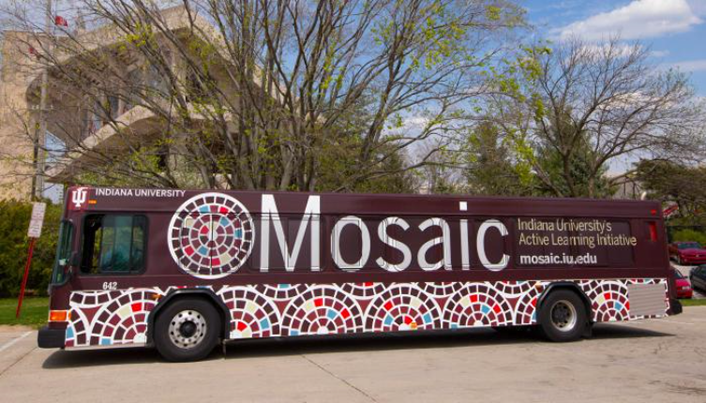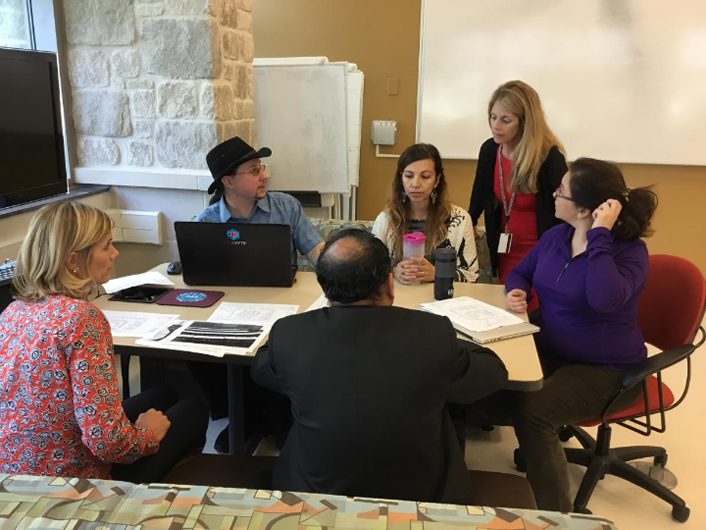
Thinking about launching a large-scale initiative — one that involves systematic change with real impact and large-scale transformation of pedagogy? Make sure you have the right people on board to inspire new possibilities.
As the Director of Learning Spaces for Indiana University, I lead the team responsible for creative and innovative learning space designs. Over the past few years, we have planned and implemented several new spaces, learning a great deal from faculty who taught in them.
We also started imagining an initiative where active learning classrooms would be built to align with faculty development, so a symbiotic relationship between the two would form. In January 2015, we set out to launch Mosaic (mosaic.iu.edu), Indiana University’s active learning initiative.
“Rather than use a single design for our active learning classrooms, we intentionally set out to design a variety of different types of classrooms that would meet a wide range of instructional needs.”
—Stacy Morrone, Associate Vice President for Learning Technologies at Indiana University
Along with several high profile launch events, a Mosaic bus toured campus to increase awareness among all stakeholders: students, faculty, and administrators. The literal bus has also led to many figurative goals related to forward progress and greater visibility.

With the Mosaic initiative reaching its first anniversary, I took the opportunity to step back and reflect on changes since the launch. It is not often we get to experience both the before/after and the overall scope/impact of an initiative. Here are four ways that transformation occurred:
1. Overall support of stakeholders: Changing expectations of what a classroom can be
The conversation regarding space planning has transformed from “should we build more active learning classrooms?” to “how many additional active classrooms should we build?” Tracey Birdwell, Mosaic’s Principal Instructional Designer, has noted, “Once faculty visit (or teach in) our Mosaic classrooms, their expectations about what a classroom can and should be change. They want all of their classrooms to support active and collaborative approaches to learning, because they know they can more easily and creatively engage their students in such spaces.”
2. Growing cadre of leading faculty: Engaging those interested in active learning
Many of our Mosaic Fellows serve on committees that inform the design of future classrooms. We also conducted a faculty forum on a specific space targeted for redesign. Not only did it open my eyes to the faculty’s perspective, but it also provided us the leverage to design an additional space based on their feedback.
Similarly, members of our technology team work collaboratively with faculty to conduct research in (and on) these spaces. We actively seek streamlined and affordable ways to capture data for studies related to student outcomes and space evaluation.
3. Shared common language and definitions
Definitions of an ‘active learning classroom’ varied among our stakeholders. A subcommittee helped to clarify what we mean, posting the definition below online to ensure that our mission is clear.
What is a Mosaic classroom?
Mosaic classrooms represent a rich variety of learning spaces that meet widely varying instructional needs — much like the unique tiles that comprise a mosaic.
Each Mosaic classroom is different, but all Mosaic classrooms support:
- Collaboration — with student-accessible screens or whiteboard surfaces intended for collaboration and presentation
- Student grouping — with flexible or fixed furniture that allows for easy student grouping
- Movement — with square footage requirements that allow space for students and instructors to interact in a variety of ways
4. Proactive faculty development, and partnerships between technical and instructional staff
To have full impact, I believe it is necessary to have 100% of the key seats on the bus filled. Within our faculty support model, our missing link was a technical support specialist who could link technology and pedagogy — and build relationships with faculty as well as the teaching center. We now bring our technical staff into the classroom with instructors, whether for a classroom observation or a faculty forum. When technical staff gain insight into how active learning spaces are used or not used, they are both better informed and more enthusiastic about making future design decisions.
Author’s Note
The Mosaic bus that circles campus was recently in an accident and out of service for a short time. Just like the physical bus, our team will also experience mishaps — a pilot using a technology that did not work, or a classroom design that was unpopular. By viewing them as opportunities, we use these failures or mishaps to shape our future path to success.
Julie Johnston serves as Director of Learning Spaces at Indiana University.
